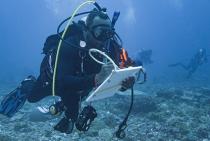A group of scientists working aboard a research vessel in the southwest Pacific Ocean has discovered the world’s largest coral. Measuring 34 meters wide, 32 meters long and 5.5 meters high, with a circumference of 183 meters, the gigantic organism is a complex network of coral polyps — tiny individual creatures — that have grown over a span of three centuries. In contrast to a reef — which is a network of many coral colonies — this structure is a standalone coral that has grown uninterrupted for hundreds of years.
You are here
Results for Marine life
Thursday 14 November 2024
Honiara, Solomon Islands
Tuesday 20 October 2020
 Premium content
Premium content
Vallejo-California, USA
New York Times: As oceans warm, algae blooms have become more widespread, creating toxins that get ingested by sardines and anchovies, which in turn get ingested by sea lions, causing damage to the brain that results in epilepsy. Sea otters also face risk when they consume toxin-laden shellfish. Early this month, Cronutt a 7-year-old Pacific sea lion underwent groundbreaking brain surgery aimed at reversing the epilepsy. By Matt Richtel.
Wednesday 25 October 2017
 Premium content
Premium content
Manila, Philippines
Urging countries to conserve and protect Blue Sharks, delegates from Samoa and Sri Lanka are defending the future of the migratory species at a conference on conserving wild animals held in Manila, Philippines from October 23-28.
Wednesday 8 June 2016
 Premium content
Premium content
Apia, Samoa
Pacific people are urged to be part of the Wave for Change social media campaign and commit to activities to protect the ocean from threats such as climate change, ocean acidification, marine pollution and overfishing as part of World Oceans Day today, 8 June. SPREP says the ocean needs to be protected from threats such as climate change, ocean acidification, marine pollution and overfishing as it plays a vital role covering 98% of the Pacific region that consists of only 2% of land area.







